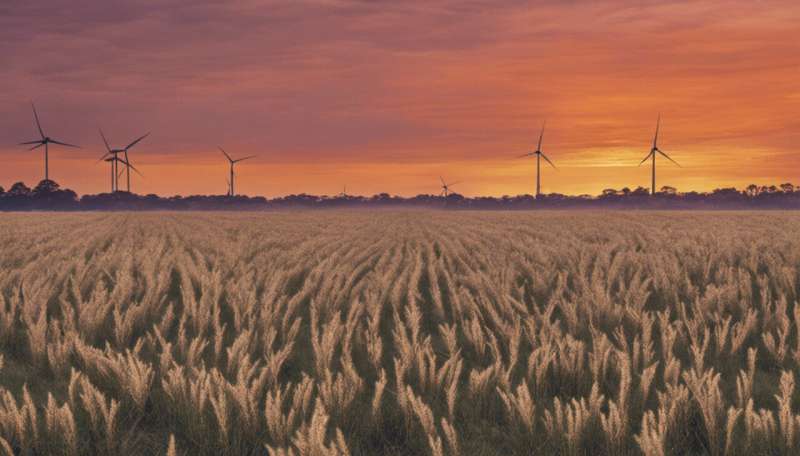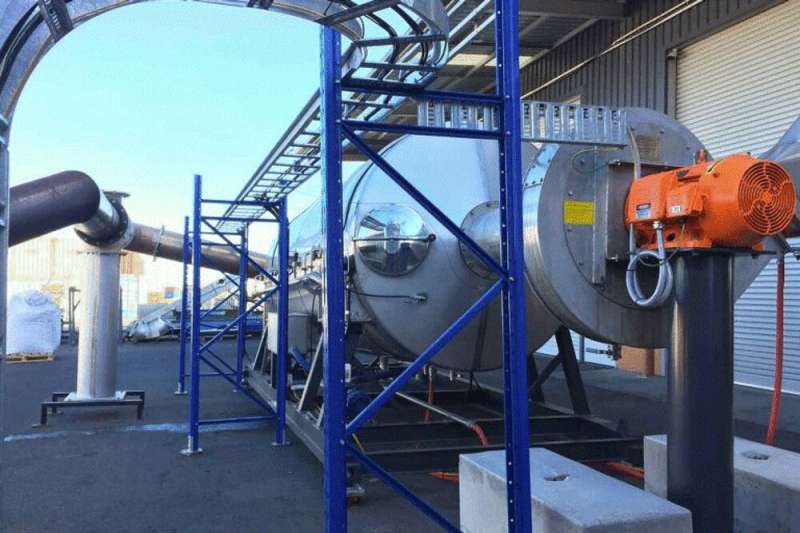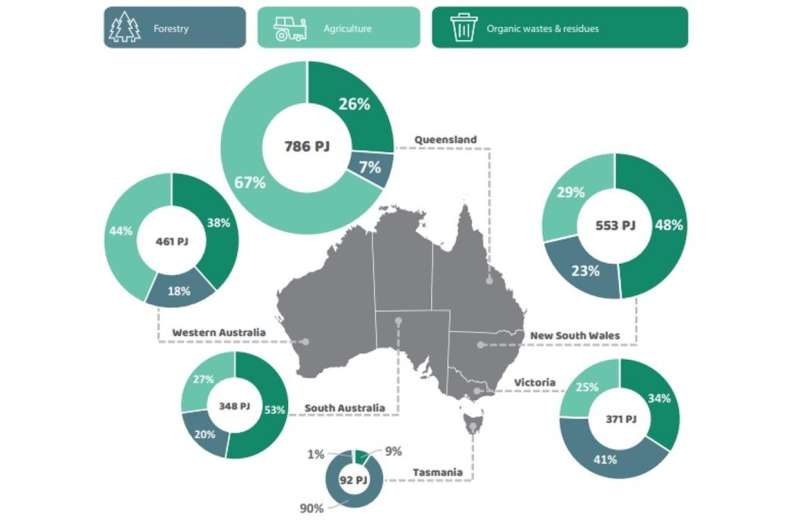At long last, Australia has a bioenergy roadmap, and its findings are startling

Using organic waste to make energy—think sewage, animal and crop residues, and leftover wood—has finally been put under the spotlight with last week’s release of Australia’s first Bioenergy Roadmap.
Bioenergy is a versatile form of renewable energy which produces heat, electricity, transport fuels, chemicals, and by-products like organic fertilizer. It’s a promising way to bring Australia’s emissions down, while re-purposing waste that would otherwise go to landfill.
The roadmap predicts that by the 2030s, the sector could boost Australia’s annual GDP by around A$10 billion, create 26,200 jobs, reduce emissions by about 9%, divert an extra 6% of waste from landfill, and enhance fuel security.
Still, bioenergy is complex and poorly understood. We were part of the roadmap review reference group, and believe it has a bright future, as the key to successful bioenergy projects is to match the right fuel source with the right technology.
Bioenergy state of play in Australia
Federal Energy Minister Angus Taylor commissioned the Australian Renewable Energy Agency to develop the roadmap and, on Friday, announced $33.5 million in funding to implement it. This is on top of more than $118 million already provided by the federal government to help fund bioenergy projects.
This funding has been a long time coming, as the sector has struggled to get the same attention from policymakers as other forms of renewable energy such as solar, wind and hydro.
In 2020, bioenergy represented only 5% of Australia’s renewable electricity generation, putting Australia at the bottom quartile of OECD countries when it comes to bioenergy as a share of total energy supply. And yet, bioenergy is responsible for nearly 50% of Australia’s current renewable energy consumption.
But the sector has started gaining traction. In 2018, Australia had 222 operating bioenergy plants and an additional 55 projects under construction or at the feasibility stage.

One example is a new project in Logan City Council in Queensland. Each year, Logan City produces 34,000 tons of biosolids (treated sewage sludge).
A technology called gasification is significantly reducing the need to dispose of these biosolids, and will save about $500,000 in operating costs. Research is also underway to see how the by-product of this treatment can be sold as a soil conditioner for agriculture.
So why is it good for the environment?
Using biomass as an energy source instead of fossil fuels can reduce carbon emissions and improve air quality. Bioenergy can be emissions-neutral, especially when wastes are used as a fuel source. This is because:
- it captures methane when organic waste breaks down. This methane would otherwise have been released to the atmosphere
- it’s used in place of fossil fuels, displacing those CO₂ emissions.
For example, the recent biomethane trial at Sydney Waters Malabar plant captures methane from sewage sludge, to replace fossil natural gas in the gas network.
What’s more, a strong bioenergy industry can help support Australian farmers looking for the benefits of running a carbon-neutral operation, and boost economic growth in regional areas.
Bioenergy can also have negative impacts if not developed properly. As we’ve seen in international projects, the biggest concern is inappropriate changes to land use to supply biomass. This could, for example, lead to greater deforestation in order to supply wood.
However, bioenergy technologies are neither good nor bad per se. Avoiding unintended risks depends on appropriate governance. A good example is the International Sustainability and Carbon Certification Scheme, which aims to ensure bioenergy companies are transparent and uphold ethical values.

Critics have recently voiced their concern about the federal government’s claim that bioenergy with carbon capture and storage, also known as BECCS, will cut emissions by 15% by 2050.
The International Energy Agency has identified BECCS as a technology with the potential to be truly carbon negative, which means it can remove carbon dioxide from the atmosphere while producing energy for consumption.
But the Bioenergy Roadmap did not focus on BECCS. Instead, it gave an expansive overview of all bioenergy technologies in the short to medium term, outlining where bioenergy can complement other low emissions technologies, and create opportunities for industry and governments to drive commercial growth.
A snapshot of the roadmap
The roadmap was developed following extensive consultation with industry, researchers and the public. It identified major opportunities for Australia in four key areas.
First, in hard-to-abate sectors. This includes generating renewable heat for the manufacturing industry, fuel for sustainable aviation, and renewable gas (biomethane) to displace fossil natural gas in the grid. For example, sustainable aviation biofuels are the only low-emissions alternatives to traditional, high-emitting jet fuel, that are available in the short to medium term.
Second, to complement other markets. In road transport, for example, biofuels can offer other low-emissions alternatives such as hydrogen and electric vehicles, and, in particular, can replace diesel in long-haul transport. In the grid, bioelectricity generation can support greater penetration of renewable energy such as solar and wind.
Third, in developing our understanding of our vast bioenergy resources across agriculture, forestry, and organic waste. We need further research and innovation to turn Australia’s theoretical bioenergy resource potential—which is massive in every state—into a reality.
And finally, increasing collaboration between industry, state and federal governments. For example, developing industry guidelines and standards can help produce reliable results. This in turn helps commercialize mature technologies that are new to Australia.
This article is republished from The Conversation under a Creative Commons license. Read the original article.![]()
Citation:
At long last, Australia has a bioenergy roadmap, and its findings are startling (2021, November 22)
retrieved 22 November 2021
from https://techxplore.com/news/2021-11-australia-bioenergy-roadmap-startling.html
This document is subject to copyright. Apart from any fair dealing for the purpose of private study or research, no
part may be reproduced without the written permission. The content is provided for information purposes only.
For all the latest Technology News Click Here
For the latest news and updates, follow us on Google News.
